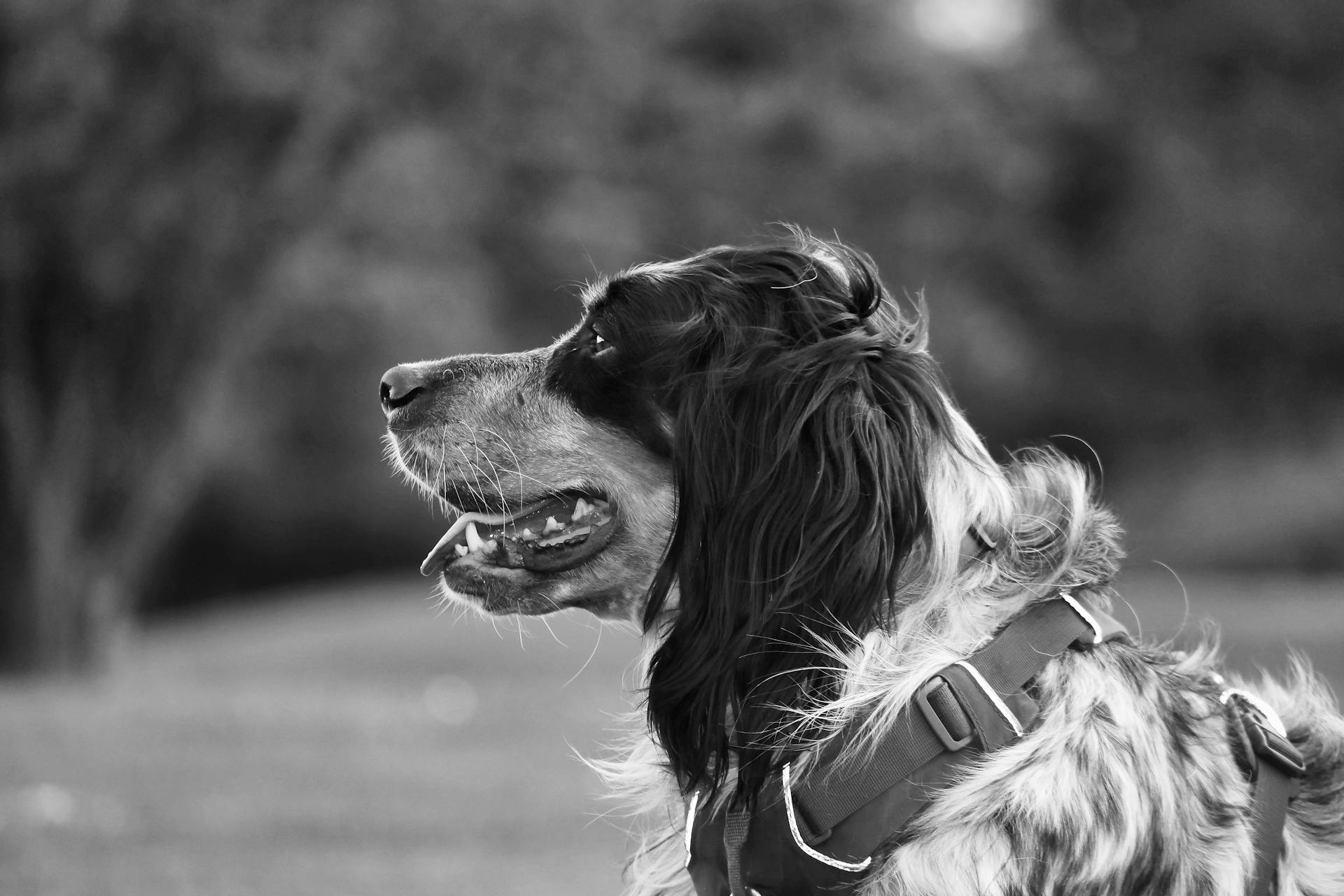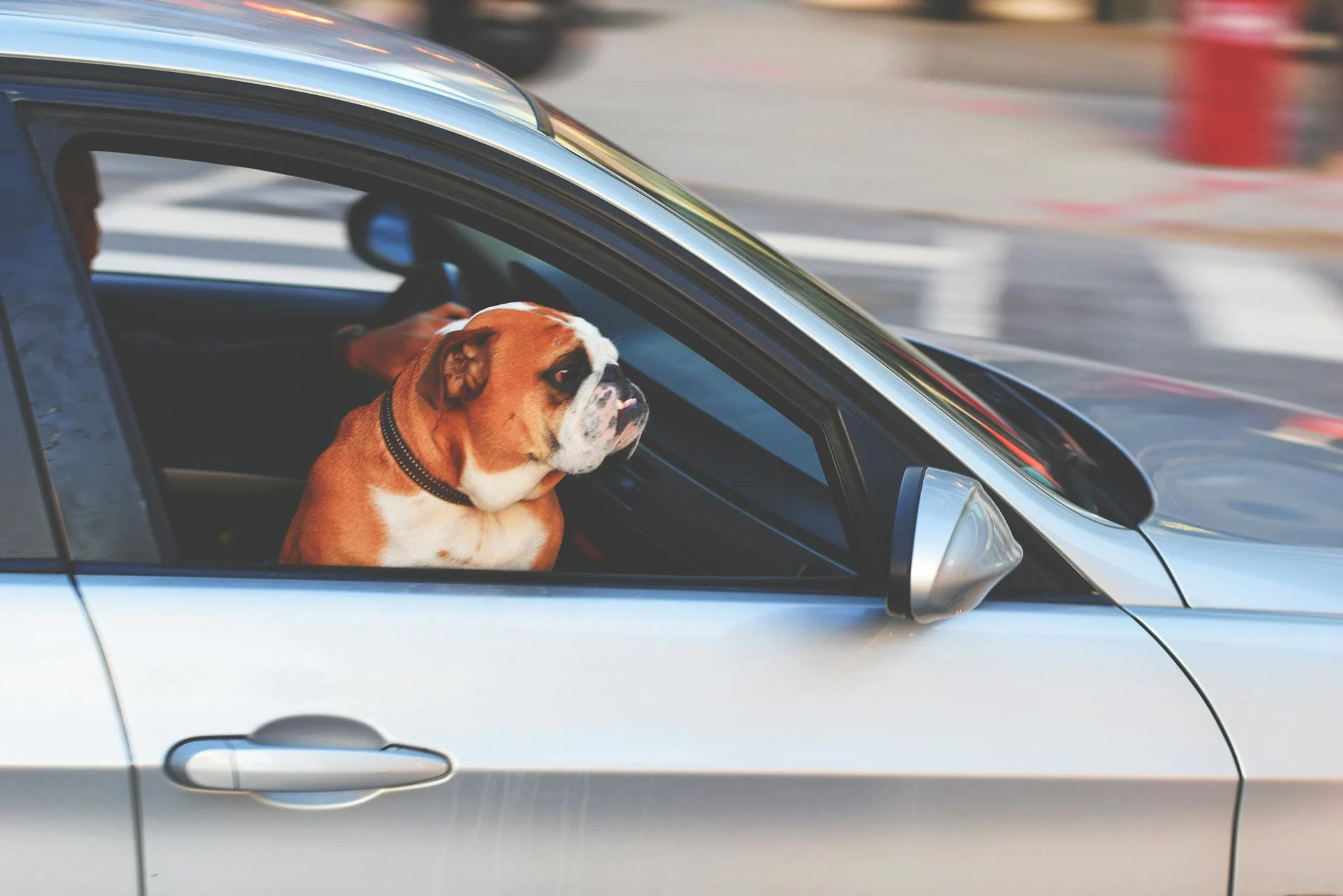
The English Mastiff is a giant breed that can weigh up to 230 pounds and stand 30 inches tall.
This massive size requires an equally impressive living space, with the ideal home being at least 1,000 square feet to accommodate their large frame.
English Mastiffs are known for their short coats, which require minimal grooming but shed heavily.
Physical Characteristics
The English Mastiff is an impressive breed with some truly massive physical characteristics. The minimum height for a male Mastiff at the shoulder is 30 inches; for females, it’s 27.5 inches.
Their weight ranges from 130 pounds to 220 pounds or more, making them one of the largest dog breeds in terms of mass. Some dogs can be smaller or larger than average, but this gives you an idea of what to expect.
Here are some key physical characteristics to look out for:
- Ears: Mastiff ears are small compared with their very large head and are V-shaped with rounded tips.
- Eyes: Mastiff eyes are wide-set, medium in size and brown (the darker the better).
- Nose: A Mastiff's muzzle is half the length of their head, and their nose is broad and dark in color (black is preferred).
- Coat Length: Mastiffs are short-coated pups with a dense outer coat and a short, close-lying undercoat.
- Coat Color: Their coat colors consist of fawn, apricot or brindle (subtle tiger stripes).
- Tail: A Mastiff tail is wide at the base and tapers toward the end, and it may hang straight or curve slightly upward.
Overall, the English Mastiff's physical characteristics are truly unique and make them a standout breed.
Size
The Mastiff is a massive dog breed, with males reaching a minimum height of 30 inches at the shoulder and females at 27.5 inches.
Weight ranges from 130 pounds to 220 pounds or more, making them one of the heaviest breeds around. Some individuals can be smaller or larger than average, but overall, they're quite big dogs.
A typical male Mastiff can weigh anywhere from 150-250 pounds, while a typical female weighs between 120-200 pounds. Very large individuals have even been known to reach weights of 300 pounds or more.
Here are some key size statistics for the breed:
- Minimum height for males: 30 inches
- Minimum height for females: 27.5 inches
- Weight range for males: 130-220 pounds
- Weight range for females: 120-200 pounds
Overall, the Mastiff's size is truly impressive and requires careful consideration when deciding to bring one home as a pet.
Coat Color and Grooming
The Mastiff's coat color is a defining feature of this breed. Their short, straight outer coat comes in fawn, apricot, or brindle colors.
The brindle pattern features dark stripes over a fawn or apricot background, and it's considered one of the most attractive and desirable colors among Mastiffs. The muzzle, nose, ears, and eye rims should be dark, with black being the preferred color.
A unique perspective: Fawn Boston Terrier

A small patch of white on the chest is also common in Mastiffs. Brushing their coat weekly can help keep them looking their best, especially during shedding season when they tend to drop a lot of hair.
You'll want to use a rubber hound glove or stripping blade to remove excess hair and prevent matting. It's essential to get your Mastiff accustomed to being brushed from an early age, so start handling their paws and checking for any skin issues regularly.
Here are some key things to check during grooming:
- Sores, rashes, or signs of infection on the skin, nose, mouth, eyes, and feet
- Redness or discharge in the eyes
By being diligent about grooming and regular health checks, you can help prevent potential health problems from arising.
Personality
The English Mastiff is a gentle giant, but don't let their size fool you - they're also fiercely protective of their family.
Their grandeur and good nature make them a joy to be around, as long as you treat them with respect. A well-socialized Mastiff will politely ignore strangers, but stand up for you if anyone or anything seems threatening.
These dogs are not typically aggressive, unless provoked - and even then, they'll only escalate their response as needed. Thieves who break into a home with a Mastiff will find themselves cornered until the family returns to call the police.
Mastiffs dislike conflict between family members and will step in to mediate disputes between arguing spouses or parents punishing children. They're sensitive dogs, so never treat them roughly - not even by accident.
Puppies with nice temperaments are curious and playful, willing to approach people and be held by them. Meeting the parents of a potential puppy can give you an idea of what their temperament will be like when they grow up.
Early socialization is key for Mastiffs, exposing them to many different people, sights, sounds, and experiences when they're young. Enrolling them in a puppy kindergarten class or taking regular leisurely strolls with visitors can help polish their social skills.
A different take: Best Time to Breed a Female Dog
Health and Care
The English Mastiff is a large dog with specific needs when it comes to exercise and diet.
A UK study found that the breed has an average life expectancy of 9 years, which can be influenced by regular care and proper feeding. Regular exercise must be maintained throughout the dog's life to discourage slothful behavior and prevent health problems such as obesity.
Mastiffs should not be fed one large meal per day, as this can increase the chance of gastric torsion, a major problem that can affect the breed. Instead, they should be fed two or three times a day.
If this caught your attention, see: Large Münsterländer
Coat Colour Standards
The Mastiff coat comes in a variety of colours, including fawn, apricot, and brindle. The brindle colour has a fawn or apricot background with dark stripes.
For grooming purposes, it's essential to brush your Mastiff's coat weekly with a rubber hound glove, especially during the spring and fall shedding season when they may shed more heavily. This will help keep flying hair under control.
For your interest: Amstaff Fawn
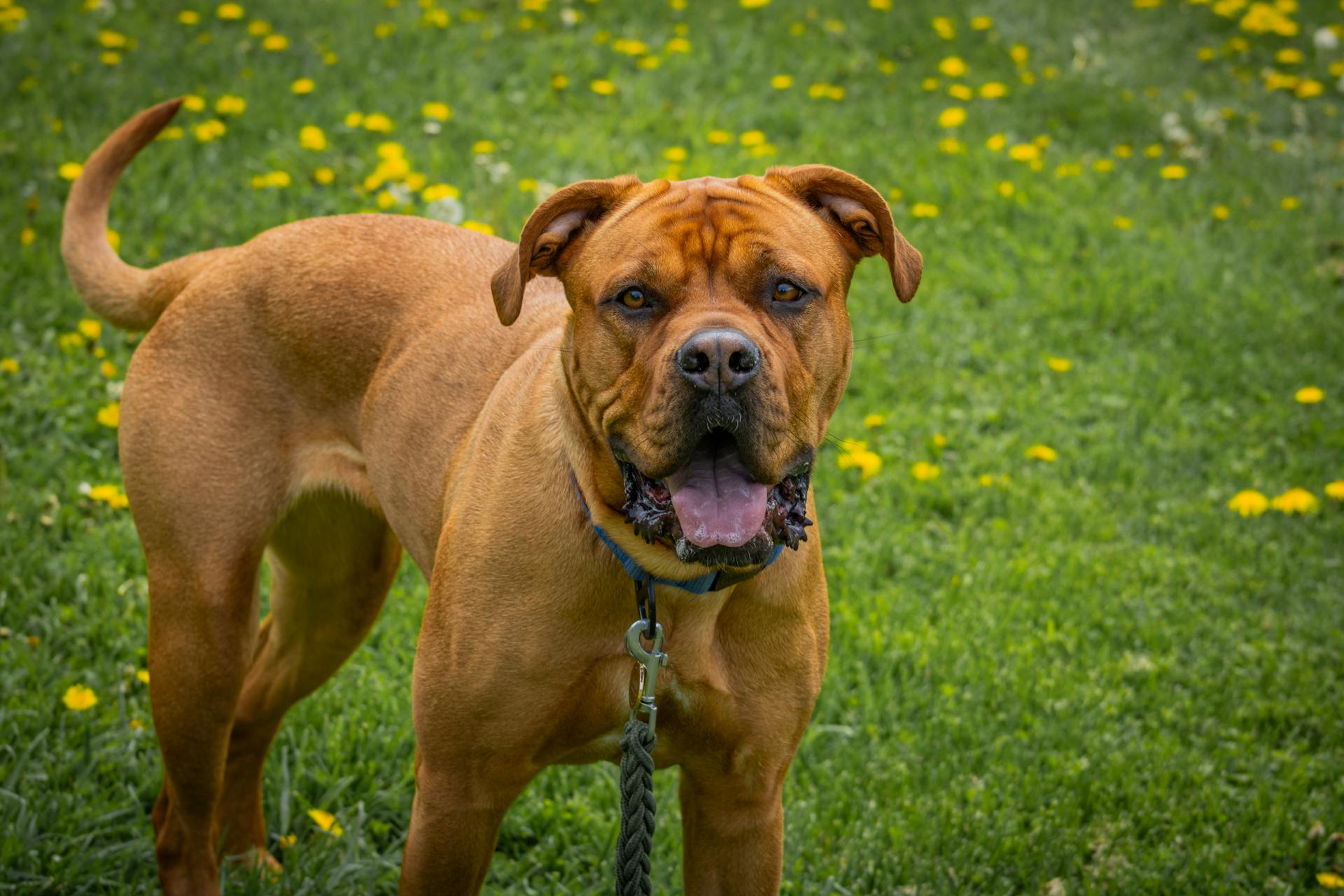
The AKC considers a long coat in Mastiffs as a fault but not cause for disqualification. However, some Mastiffs can have a recessive gene that causes them to grow a longer coat, known as "Fluffies".
When checking your Mastiff's coat, look out for sores, rashes, or signs of infection such as redness, tenderness, or inflammation on the skin, nose, mouth, eyes, and feet. Regular weekly exams will help you spot potential health problems early.
Here are some key colour standards to keep in mind:
- Fawn colours can range from a light silver shade to golden yellow.
- Apricot colours can be a slightly reddish hue up to a deep, rich red.
- Brindle markings should ideally be heavy, even, and clear stripes but may be light, uneven, patchy, faint, or muddled.
Remember that brindle is dominant over solid colour, except for black. Apricot is also dominant over fawn, although this dominance may be incomplete.
Care
Mastiffs are large dogs that require regular care and grooming to look and feel their best. They should receive light obedience training to ensure they remain safe and good companions.
To prevent health problems, it's essential to feed your Mastiff correctly. Feeding two or three times a day can help reduce the risk of gastric torsion, which is more likely to occur with one large meal per day.
You might like: Big Mountain Dogs
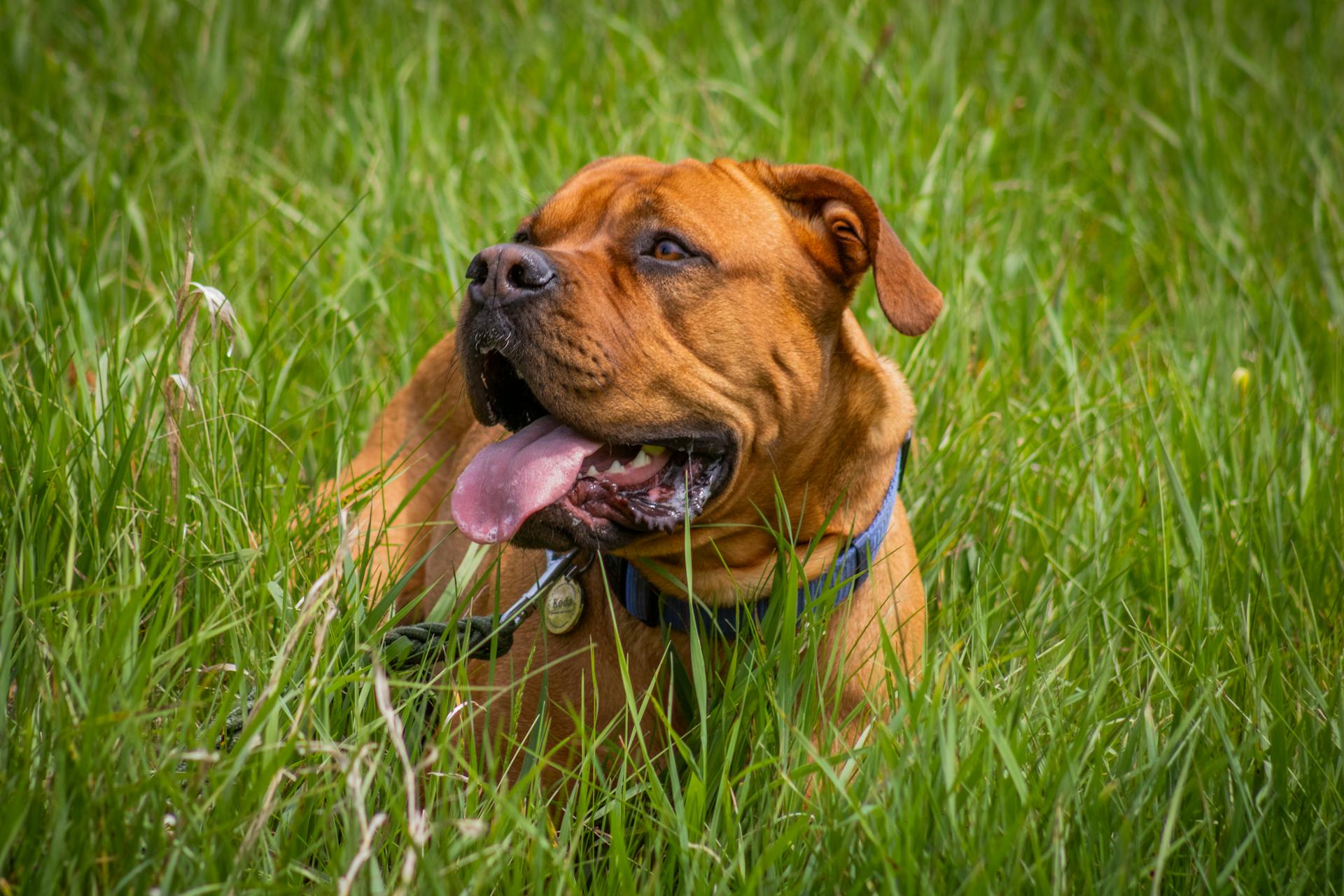
Mastiffs are prone to hip dysplasia and elbow dysplasia, inherited orthopedic conditions that affect their joints. Regular veterinary check-ups can help identify these issues early on.
A Mastiff's diet should be monitored closely, as excessive running during the first two years of life can damage their growth plates in the joints. A soft surface is recommended for sleeping to prevent calluses, arthritis, and hygroma.
Here are some common health problems that can affect Mastiffs:
- Hip dysplasia
- Elbow dysplasia
- Gastric torsion (bloating)
- Elbow hygroma (a swollen, painless area filled with fluid)
- Cancer (especially lymphoma and osteosarcoma)
- Eye issues (such as ectropion, entropion, cataracts, PRA, PPM, retinal dysplasia, and macroblepharon)
Regular exercise is also crucial to prevent slothful behavior and various health problems. A Mastiff may be kept in an apartment if given enough exercise, but a soft surface for sleeping can help prevent calluses, arthritis, and hygroma.
A UK study found that the average life expectancy of a Mastiff is around 9 years.
Pros of
Mastiffs are known for their gentle nature, making them a great companion for families with children.
Their loyal personalities also mean they'll stick by your side through thick and thin.
As they age, Mastiffs become endearingly lazy, which can be a blessing for those who value a relaxed home environment.
This laid-back attitude can actually help reduce stress levels in the household.
Cons
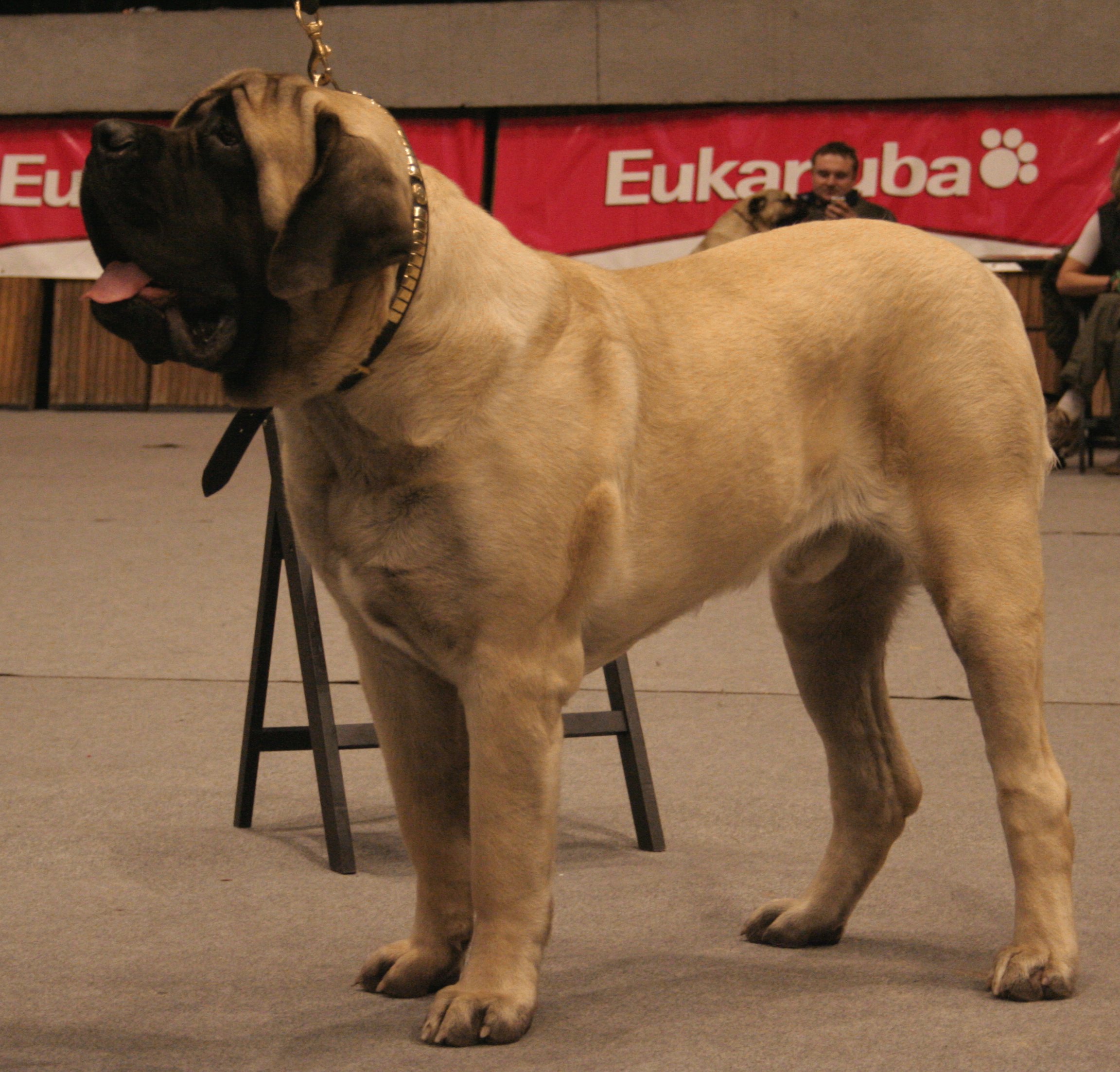
Mastiffs can be heavy droolers, so be prepared for a slobbery mess if you bring one home.
Their large tails require extra space in your home, especially if you have a small living area. This might mean rearranging furniture or finding creative ways to keep the tail from knocking things over.
Mastiffs are also heavy chewers, which can be a problem if you have valuable items that need protection.
For another approach, see: German Shorthaired Pointer Free to Good Home
Training and Exercise
English Mastiffs are a delight to exercise with, and they thrive on routine physical activity. They need at least 30-60 minutes of playtime each day, split into multiple sessions if needed.
Their size means they do better in cool weather, so try to schedule outdoor activities during the cooler parts of the day in summer. As for indoor exercise, mastiffs are perfectly happy playing and exercising indoors, even in a small apartment or house with a fenced yard.
To keep your English Mastiff happy and healthy, remember that training is just as important as exercise. They're eager to please and respond well to positive reinforcement methods, making training sessions fun and engaging. Keep these short to maintain their attention and focus.
Here are some fun activities you can try with your mastiff:
- Pulling carts
- Obedience
- Tracking
- Search and rescue
- Lounging on the couch (just kidding, but they do love to relax!)
Don't forget to socialize your English Mastiff well, especially as they grow and mature. This will help them develop good manners around visitors and prevent overprotectiveness.
Training
Training is a vital part of owning a Mastiff. Proper training and socialization are both important for this breed.
Mastiffs are eager to please and learn quickly, making them responsive to positive reinforcement methods that make training fun. They can become bored with repetitive approaches, so it's essential to keep training sessions short and sweet yet still engaging.
Their intelligence allows them to read body language and expressions, which means wearing a smile and using positive language will go a long way in their learning process. A raised voice can actually bother them, so be sure to use calm teaching methods.
To prevent jumping and leash-pulling, careful attention should be given to these behaviors from an early stage. Socialization is also crucial to ensure their natural protectiveness is appropriate and they don't become overprotective around visitors.

Some fun activities you can train your Mastiff in include pulling carts, obedience training, tracking, search and rescue, and even lounging on the couch (although that one might be more of a personal preference!).
Here are some tips to keep in mind when training your Mastiff:
- Keep training sessions short to maintain their attention.
- Use positive reinforcement methods like praise and rewards.
- Provide durable chew toys to save your furniture from chewing damage.
By following these tips, you can help your Mastiff become a well-behaved and loving companion.
Exercise
Exercise is essential for mastiffs to stay fit and motivated.
Younger dogs are more playful and can benefit from regular exercise sessions, but as they mature, an endearing quality of aloof laziness often develops.
Routine exercise will help keep your mastiff healthy and happy, aiming for at least 30-60 minutes or more each day, split into multiple sessions if needed.
Mastiffs do better in cool weather than in hot weather, so it's best to exercise them during the cooler parts of the day.
They can thrive indoors, even in an apartment or a house with a fenced yard.
History and Origins
The English Mastiff has a rich history that spans over 2,000 years, with its origins dating back to ancient times.
Their ancestors can be traced back to the Molosser, a solidly built dog breed from Asia, and were used for guarding flocks from predators in cold, high passes. These early Molossers would have been used for their strength and courage to protect valuable livestock.
The English Mastiff was bred for over 2,000 years in England, where they were prized for their size and courage, serving as guards, war dogs, and entertainment for millennia. The breed almost died out after the brutal sports of bear-baiting, bull-baiting, and dog-fighting were outlawed in 1835.
Mastiffs have been featured on Egyptian monuments and mentioned by Caesar when he invaded Britain, showcasing their importance throughout history.
A fresh viewpoint: 100 Years Ago Original Boston Terrier
The History of
The Mastiff breed has its roots in ancient times, with depictions on Egyptian monuments dating back to 3000 BC.

Throughout history, Mastiffs have been used for various purposes such as guarding flocks from predators, serving as war dogs, and even participating in gladiatorial fights against humans and other animals.
Mastiffs were highly prized by Kublai Khan, who kept a kennel with 5,000 Mastiffs used for hunting and war.
The breed almost ended after the brutal sports of bear-baiting, bull-baiting, and dog-fighting were outlawed in England in 1835.
However, the rise of dog shows in the mid-19th century helped bring about the Mastiff's revival.
A pair of Mastiff puppies imported from Canada after World War II helped bring them back from the brink of extinction.
The first Mastiff club was formed in the United States in 1879, and the American Kennel Club recognized the breed in 1885.
For more insights, see: American Kennel Club Lancashire Heeler
Breed Organizations
Reputable breeders are committed to breeding healthy, well-socialized puppies.
These breeders screen their breeding stock for health problems and socialize their puppies from a young age, which is essential for producing great companions.
Backyard breeders, on the other hand, prioritize making a profit over producing healthy, well-adjusted dogs.
A unique perspective: Healthy Bull Terrier
Adoption and Ownership
If you're looking for an English Mastiff, seeking out a specialized breeder is a great place to start.
Pet parents can also consider rescuing a mastiff through reputable organizations like The Mastiff Club of America, Mastiffs to Mutts Rescue Inc., or Southern States Mastiff Rescue.
Meeting one or both parents before adopting is ideal, as it gives you a better idea of your future pet's personality, size, and temperament.
You should seek out a reputable breeder with a history of healthy litters and detailed care – they should be able to answer any questions you have regarding the pedigree, health, and history of the litter and parents.
Here are some organizations that can help you adopt an English Mastiff:
- The Mastiff Club of America
- Mastiffs to Mutts Rescue Inc.
- Southern States Mastiff Rescue
Frequently Asked Questions
Is the English Mastiff a good family dog?
English Mastiffs are suitable for families with older children who know how to interact with pets, but may not be ideal for homes with toddlers or babies due to their large size
Is the English Mastiff the biggest dog?
Yes, the English Mastiff is one of the largest dog breeds in terms of height and weight. Despite its massive size, it was historically used for various roles including fighting, guarding, and hunting.
Is English Mastiff the strongest dog?
English Mastiffs have a surprising bite strength of 556 psi, making them one of the strongest-jawed breeds. Their massive size is matched by their powerful jaws.
Can an English mastiffs get aggressive?
English Mastiffs may become suspicious of everyone if not properly socialized, leading to potential aggression or shyness. Proper training and socialization are crucial to prevent defensive behavior in this giant breed.
How much does an English Mastiff dog cost?
English Mastiff puppies typically cost between $1,500 to $4,000. Researching a reputable breeder is essential for ensuring you get a healthy puppy.
Featured Images: pexels.com
